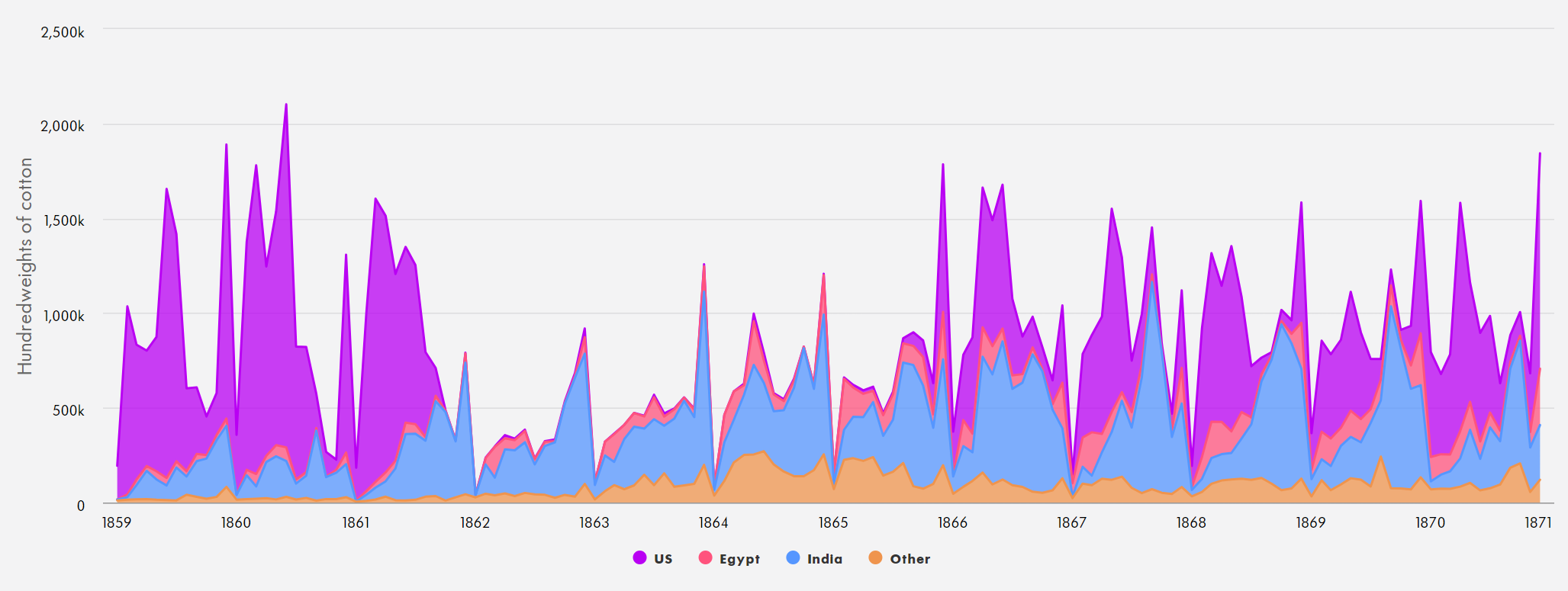2 April 2019
How Trade Wars Affect Markets

In September 2018, speaking at Alibaba’s annual investor conference in Hangzhou, the Chinese tech giant’s founder Jack Ma warned that the trade war between the USA and China could last as long as 20 years.
There are historical precedents for such a prolonged and significant shift in international trade. The American Civil War permanently reshaped the international trade in cotton, while France’s access to sugar imports was severely restricted during the Napoleonic Wars. These episodes, as well as innovations in public finance during the Nine Years’ War, show us how seemingly temporary market perturbations can prefigure important long-term changes.
‘King Cotton’ and the American Civil War (1861-1865)
One of the most significant fractures in the trade of a single commodity between nations was the sharp decline in the export of cotton from America to Britain during the American Civil War. At the start of the internecine conflict, when Confederate forces opened fire on Fort Sumter, South Carolina in April 1861, the textile industry was central to the British economy: exports of cotton cloth made up 38% of British trade revenue in 1860. And the vast majority of the raw cotton used to manufacture textiles in British cotton mills came from the American south – around 80% throughout the 1850s.
Jefferson Davis and other Confederate leaders were aware of this dependency and tried to exploit it by pursuing a policy known as ”King Cotton Diplomacy”. The premise was to try to secure British diplomatic support for the Confederacy by stopping all cotton exports from the Southern plantations to Britain. As can be seen in the chart below, British imports of cotton from America were non-existent between 1862 and 1865.
British Imports of Cotton, 1859-1870

This example of attempted trade manipulation for political purposes failed. Rather than being cowed into supporting the Confederacy, British textile manufacturers found alternative suppliers of cotton – in India, Brazil, Egypt and northern Australia. Egypt’s cotton exports, for example, increased from 27,000 tons in 1861 to 90,000 in 1865. In the end, the Confederacy only ended up harming itself as it diminished the main source of its own wealth. Even as Confederate leaders came to realise the flaws in this strategy, the south was unable to resume exporting cotton in any significant quantity. By then, the union had established a robust sea blockade, which restricted the Confederacy’s ability to export goods.
France and Britain During the Napoleonic Wars (1803-1815)
Conflict during the Napoleonic Wars – despite landmark battles such as Trafalgar and Waterloo – was conducted largely through trade embargoes, blockades and the formation of international alliances. The aim was to disrupt the trade of enemy nations with as many of their economic partners as possible. One of Napoleon’s principal strategic goals was to decimate British exports and engender a balance-of-payments crisis. Historians have argued that Napoleon was animated by a mercantilist desire to stop Britain from earning precious metals through trade.
The most important measure Napoleon took to achieve this was the Berlin Decree of 1806. This embargoed trade in all British goods not only with France but with all of France’s colonies, vassal states and allies under the guise of what became known as the Continental System. As France became increasingly militarily dominant, it brought more nations into the fold of its Continental System, meaning that by 1810, Britain’s trade with Europe was significantly curtailed.
Britain responded in kind by using superior naval power to impose a blockade on all seaborne trade that involved France and its continental allies. As can be seen in the chart below, after 1806, France experienced a sharp decline in registered imports as the sea blockade used by Britain increasingly cut France off from its colonies and the overseas markets it relied upon to import various commodities.
Sugar Lows
This led to a scarcity in France of several important goods, most notably sugar. Before the outbreak of the war, sugar was one of France’s principal imports and a thriving ancillary industry had developed around its production. With France virtually bereft of access to its remaining sugar colonies in the Caribbean, however, too little sugar was being imported to justify the existence of refineries. In Bordeaux, the number of sugar refineries slumped in two decades from 40 to eight by 1809. The scarcity of sugar became so acute that Napoleon was forced to issue a decree in 1811 promoting national beet cultivation.
Ultimately, France suffered badly from the dislocation to trade during these years. Britain, by contrast, tapped new markets in Latin America – which accounted for 15% of all British manufactured exports in the early 1820s, up from a mere 0.06% in the 1780s.
The long-run impact of trade
These episodes were short-term shocks in response to a discrete set of events. But following both the Napoleonic Wars and the American Civil War, the changes that had occurred in international trading relationships were to have dramatic and lasting effects.
In the case of the Napoleonic Wars, the blockades ultimately led to the formation of protectionist lobby groups in many European economies. Meantime, trading relationships between Britain and Latin America, forged out of necessity, became enduring ones. Similarly, disruptions to sugar imports forced affected nations to innovate and fuelled the rise of beet cultivation in Europe, which became important in sugar production during the 19th century.
The American Civil War, meanwhile, resulted in a long-lasting change to US trade policy, as the “temporary” wartime duties became permanent tariffs. It also altered the composition of the cotton market as other nations, among them Egypt and India, emerged as leading exporters of cotton to Europe. America found itself to be a less influential player in a more competitive marketplace once the war had ended.
Invention through necessity
Shocks to international trade have spurred significant innovations. Britain developed a system of public credit and a liquid secondary market in securities during the Nine Years’ War, from 1688 to 1697. With British trade devastated by the country’s loss of control of the seas, merchants with surplus capital chose to loan it to the government at interest or invest it in shares in new joint-stock ventures.
Merchants deprived of their former opportunities took a leading role in the incipient trade in securities centred on Change Alley in London, where they assumed broking and market-making functions in the secondary markets. The chart below shows that merchants involved in overseas trade were also the principal investors in the early Bank of England, established during the Nine Years’ War in 1694 as a means for the government to raise finance.



